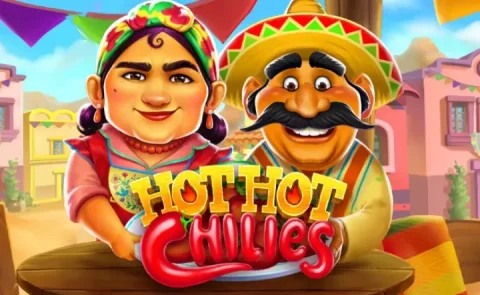



Are you ready to spice up your life? There's nothing quite like the heat and flavor of hot chilies to add some excitement to your taste buds.
But did you know that these fiery little peppers can also bring some excitement to your online gaming experience? If you're a fan of Gambino Slots and free spins, you're in luck - we've got the perfect way to add some extra spice to your next gaming session. In this article, we'll explore the fascinating world of hot chilies and how they can add flavor, spice, and even some health benefits to your life. From the hottest peppers in the world to the best ways to incorporate them into your favorite dishes, we'll cover it all. So buckle up, get ready to sweat, shed a few tears, and savor the deliciousness of hot chilies - both in your cooking and your free slots gaming. Let's dive in!
Hot chilies get their heat from a compound called capsaicin. This compound stimulates the nerve endings in your mouth, causing a burning sensation and triggering your body's natural pain response. The spiciness of a chili pepper is measured on the Scoville scale, which assigns a number based on the concentration of capsaicin. The higher the number, the hotter the pepper. But what exactly happens in your body when you eat a hot chili? When capsaicin comes into contact with your taste buds, it binds to certain receptors that are responsible for sensing heat and pain. This sends a signal to your brain, which interprets it as a burning sensation. Your body responds by releasing endorphins, which are natural pain relievers. This is why some people actually enjoy the heat of hot chilies - it can give them a natural high! The heat of a chili pepper can vary greatly depending on the variety and how it is prepared. Some peppers, like the Carolina Reaper or the Trinidad Moruga Scorpion, are so hot that they can cause extreme discomfort or even physical harm if not consumed with caution. On the other end of the spectrum, milder peppers like jalapenos or poblanos can add a subtle kick without overpowering your taste buds.
Aside from their fiery flavor, hot chilies also come with a range of health benefits. Capsaicin, the compound responsible for the spiciness, has been shown to have anti-inflammatory properties. It can help reduce pain and inflammation, making it a popular ingredient in topical creams and ointments for conditions like arthritis or muscle soreness. Additionally, capsaicin has been found to boost metabolism and promote weight loss. It increases the production of heat in your body, a process known as thermogenesis, which can help burn calories and fat. Some studies have also suggested that capsaicin may have cancer-fighting properties and can help lower blood pressure and cholesterol levels. But it's not just capsaicin that makes hot chilies a healthy choice. They are also packed with vitamins, minerals, and antioxidants. They are a great source of vitamin C, which is essential for a healthy immune system. They also contain vitamin A, potassium, and iron. The antioxidants found in hot chilies help protect your cells from damage caused by free radicals and can reduce the risk of chronic diseases.
Hot chilies come in a wide variety of shapes, sizes, and flavors. Each type has its own unique characteristics and uses in cooking. Let's take a closer look at some of the most popular types of hot chilies and how they can be used:
Before you start cooking with hot chilies, it's important to know how to handle them properly. The capsaicin in chilies can cause skin irritation and even burns, so it's a good idea to wear gloves when handling them. Avoid touching your face or eyes, as the oils from the peppers can cause a painful burning sensation. To prepare hot chilies, start by washing them thoroughly under cold water. Remove the stems and seeds, as this is where most of the heat is concentrated. If you want to reduce the spiciness even further, you can soak the chilies in water or milk for a few minutes before using them in your recipe. When it comes to cooking with hot chilies, there are countless possibilities. You can add them to soups, stews, or sauces for an extra kick of heat. They can be used to flavor marinades, dressings, or even desserts. Some people even enjoy eating them raw, either on their own or as a garnish for dishes like tacos or salads.
Hot chilies have a long history and play a significant role in many cultures around the world. In Mexican cuisine, for example, chili peppers are a fundamental ingredient and are used in dishes like mole, tamales, and enchiladas. They are also an important part of traditional Indian cuisine, where they are used in curries, chutneys, and pickles. In addition to their culinary uses, hot chilies have cultural and spiritual significance in many societies. In some cultures, they are believed to bring good luck or ward off evil spirits. They are also used in traditional medicine for their healing properties.
If you're a true chili enthusiast, you may be curious about the hottest peppers in the world. Here are the top 10 hottest chilies, ranked based on their Scoville scale rating
For some people, the heat of a hot chili is not just a culinary experience - it's a challenge. There are various contests and challenges around the world that involve eating extremely spicy chilies. These challenges range from eating a certain number of hot chilies within a short time frame to consuming sauces or dishes made with the hottest peppers in the world. One famous challenge is the "Hot Wing Challenge," where participants have to eat a certain number of chicken wings coated in a sauce made with the hottest chilies available. Another popular challenge is the "Chili Eating Contest," where participants compete to eat the most chilies within a given time limit. These challenges can be intense and not for the faint of heart!
Now that you're familiar with the different types of hot chilies and their uses, it's time to put your newfound knowledge to use in the kitchen. Here are a few hot chili recipes from around the world to get you started:
Hot chilies are more than just a way to add some heat to your dishes - they can bring excitement, flavor, and even health benefits to your life. From their spicy kick to their cultural significance, hot chilies have a fascinating history and a wide range of uses in the culinary world. Whether you're a fan of mild jalapenos or brave enough to try the Carolina Reaper, there's a hot chili out there for everyone. So the next time you're in the mood for some extra spice, don't be afraid to reach for the hot chilies. Experiment with different types, try new recipes, and embrace the heat. Whether you're cooking up a storm in the kitchen or enjoying a thrilling gaming session, hot chilies are sure to add some flavor and spice to your life. So go ahead, sweat a little, shed a few tears, and savor the deliciousness of hot chilies - you won't be disappointed!
